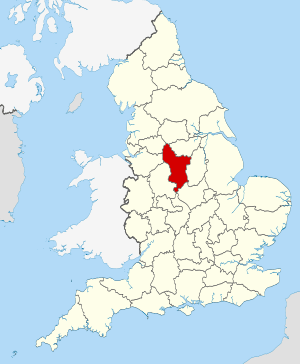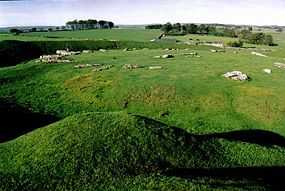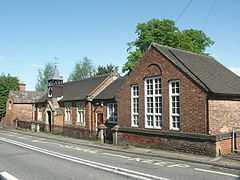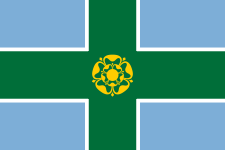Derbyshire
| Derbyshire | |||||
|---|---|---|---|---|---|
| County | |||||
| |||||
| Motto: "Bene consulendo" ("By wise deliberation") | |||||
 Derbyshire shown within England | |||||
| Coordinates: 53°8′N 1°36′W / 53.133°N 1.600°WCoordinates: 53°8′N 1°36′W / 53.133°N 1.600°W | |||||
| Sovereign state | United Kingdom | ||||
| Constituent country | England | ||||
| Region | East Midlands | ||||
| Established | Ancient | ||||
| Ceremonial county | |||||
| Lord Lieutenant | William Tucker | ||||
| High Sheriff | Derek Mapp | ||||
| Area | 2,625 km2 (1,014 sq mi) | ||||
| – Ranked | 21st of 48 | ||||
| Population (2011 est.) | 1,019,500 | ||||
| – Ranked | 20th of 48 | ||||
| Density | 388/km2 (1,000/sq mi) | ||||
| Ethnicity |
96.0% White 2.3% S. Asian 1.7% Black, Mixed Race or Chinese | ||||
| Non-metropolitan county | |||||
| County council | Derbyshire County Council | ||||
| Executive | Conservative | ||||
| Admin HQ | Matlock | ||||
| Area | 2,547 km2 (983 sq mi) | ||||
| – Ranked | 20th of 27 | ||||
| Population | 770,600 | ||||
| – Ranked | 11th of 27 | ||||
| Density | 303/km2 (780/sq mi) | ||||
| ISO 3166-2 | GB-DBY | ||||
| ONS code | 17 | ||||
| GSS code | E10000007 | ||||
| NUTS | UKF12, UKF13 | ||||
| Website |
www | ||||
 Districts of Derbyshire Unitary County council area | |||||
| Districts | |||||
| Members of Parliament | List of MPs | ||||
| Police | Derbyshire Constabulary | ||||
| Time zone | GMT (UTC) | ||||
| – Summer (DST) | BST (UTC+1) | ||||
Derbyshire (![]() i/ˈdɑrbɨʃər/ or /ˈdɑrbɪʃɪər/; abbreviated Derbys. or Derbs.) is a county in the East Midlands of England. A substantial portion of the Peak District National Park lies within Derbyshire. The southern extremity of the Pennine range of hills extends into the north of the county. The county contains part of the National Forest, and borders on Greater Manchester to the northwest, West Yorkshire to the north, South Yorkshire to the northeast, Nottinghamshire to the east, Leicestershire to the southeast, Staffordshire to the west and southwest and Cheshire also to the west. In 2003 the Ordnance Survey placed Church Flatts Farm, near Coton in the Elms, as the furthest point from the sea in Great Britain.[1][2]
i/ˈdɑrbɨʃər/ or /ˈdɑrbɪʃɪər/; abbreviated Derbys. or Derbs.) is a county in the East Midlands of England. A substantial portion of the Peak District National Park lies within Derbyshire. The southern extremity of the Pennine range of hills extends into the north of the county. The county contains part of the National Forest, and borders on Greater Manchester to the northwest, West Yorkshire to the north, South Yorkshire to the northeast, Nottinghamshire to the east, Leicestershire to the southeast, Staffordshire to the west and southwest and Cheshire also to the west. In 2003 the Ordnance Survey placed Church Flatts Farm, near Coton in the Elms, as the furthest point from the sea in Great Britain.[1][2]
The city of Derby is a unitary authority area, but remains part of the ceremonial county of Derbyshire. The non-metropolitan county contains 30 towns with between 10,000 and 100,000 inhabitants. There is a large amount of sparsely populated agricultural upland: 75% of the population live in 25% of the area.
History
The area that is now Derbyshire was first visited, probably briefly, by humans 200,000 years ago during the Aveley interglacial as evidenced by a Middle Paleolithic Acheulean hand axe found near Hopton.[3]
Further occupation came with the Upper Paleolithic and Neolithic periods of the Stone Age when Mesolithic hunter gatherers roamed the hilly tundra.[4] Evidence of these nomadic tribes has been found in limestone caves located on the Nottinghamshire border. Deposits left in the caves date the occupancy at around 12,000 to 7,000 BCE.[5]

Burial mounds of Neolithic settlers are also situated throughout the county. These chambered tombs were designed for collective burial and are mostly located in the central Derbyshire region.[5] There are tombs at Minninglow and Five Wells that date back to between 2000 and 2500 BCE.[6] Three miles west of Youlgreave lies the Neolithic henge monument of Arbor Low, which has been dated to 2500 BCE.
It is not until the Bronze Age that real signs of agriculture and settlement are found in the county. In the moors of the Peak District signs of clearance, arable fields and hut circles were discovered after archaeological investigation. However this area and another settlement at Swarkestone are all that have been found.[7]
During the Roman invasion the invaders were attracted to Derbyshire because of the lead ore in the limestone hills of the area. They settled throughout the county with forts built near Brough in the Hope Valley and near Glossop. Later they settled around Buxton, famed for its warm springs, and set up a fort near modern-day Derby in an area now known as Little Chester.[7]
Several kings of Mercia are buried in the Repton area.[8]
Following the Norman Conquest, much of the county was subject to the forest laws. To the northwest was the Forest of High Peak under the custodianship of William Peverel and his descendants. The rest of the county was bestowed upon Henry de Ferrers, a part of it becoming Duffield Frith. In time the whole area was given to the Duchy of Lancaster. Meanwhile the Forest of East Derbyshire covered the whole county to the east of the River Derwent from the reign of Henry II to that of Edward I.[9]
Economy
Derbyshire has a mixture of a rural economy in the west, with a former coal mining economy in the northeast (Bolsover district), the Erewash Valley around Ilkeston and in the south around Swadlincote. The rural landscape varies from arable farmland in the flat lands to the south of Derby, to upland pasture and moorland in the high gritstone uplands of the southern Pennines.
Derbyshire is rich in natural mineral resources such as lead, iron, coal, and limestone, which have been exploited over a long period—lead, for example, has been mined since Roman times. The limestone outcrops in the central area led to the establishment of large quarries to supply the industries of the surrounding towns with lime for building and steelmaking, and latterly in the 20th century cement manufacture. The industrial revolution also increased demand for building stone, and in the late 19th and early 20th century the railways' arrival led to a large number of stone quarries being established. This industry has left its mark on the countryside but is still a major industry: a lot of the stone is supplied as crushed stone for road building and concrete manufacture, and is moved by rail.

Derbyshire's relative remoteness in the late 18th century and an abundance of fast-flowing streams led to a proliferation of the use of hydropower at the beginning of the Industrial Revolution, following the mills pioneered by Richard Arkwright. Derbyshire has been said to be the home of the Industrial Revolution, and part of the Derwent Valley has been given World Heritage status in acknowledgement of this historic importance.
Nationally famous companies in Derbyshire include Rolls Royce, one of the world's leading aerospace companies, based since before World War I in Derby, Thorntons just south of Alfreton and Toyota, who have one of the UK's largest car manufacturing plants at Burnaston. Ashbourne Water used to be bottled in Buxton by Nestlé Waters UK until 2006 and Buxton Water still is.
Politics

Derbyshire has a three-tier local government since the local government reorganisation in 1974. It has a county council based in Matlock and eight district councils and since 1997, a unitary authority area of the City of Derby. Derby remains part of Derbyshire only for ceremonial purposes.
Derbyshire has become smaller during government re-organisation over the years. The Sheffield suburbs Mosborough, Totley and Dore were previously parts of the county, but were lost to South Yorkshire in the late 1960s. Marple Bridge was transferred to the Metropolitan Borough of Stockport in Greater Manchester. However, Derbyshire gained part of the Longdendale valley and Tintwistle from Cheshire in 1974.
At the third tier are the parish councils, which do not cover all areas. The eight district councils in Derbyshire and the unitary authority of Derby are shown in the map above.
These district councils are responsible for local planning and building control, local roads, council housing, environmental health, markets and fairs, refuse collection and recycling, cemeteries and crematoria, leisure services, parks, and tourism.[10] Education, social services, libraries, main roads, public transport, policing and fire services, trading standards, waste disposal and strategic planning are the responsibility of the County Council.[10]
The county is divided into ten constituencies for the election of Members of Parliament (MPs) to the House of Commons. As of May 2010, five constituencies are represented by Labour MPs, while the remaining five elected a Conservative MP. Derbyshire residents are part of the electorate for the East Midlands constituency for elections to the European Parliament.[11]

Although Derbyshire is in the East Midlands, some parts, such as High Peak (which incorporated former areas of Cheshire after boundary changes in 1974), are closer to the northern cities of Manchester and Sheffield and these parts do receive services which are more affiliated with northern England; for example, the North West Ambulance Service, Granada Television and United Utilities serve the High Peak and some NHS Trusts within this region are governed by the Greater Manchester Health Authority. Outside the main city of Derby, the largest town in the county is Chesterfield.
Education
For a list of individual schools see List of schools in Derbyshire
The Derbyshire school system is comprehensive with no selective schools.
The independent sector includes Repton School, Trent College and The Elms School.
Settlements
There are several towns in the county with Derby being the largest and most populous. At the time of the 2011 census, a population of 770,600 lived in the county with 248,752 (32%) living in Derby. The table below shows all towns with over 10,000 inhabitants.
| Rank | Town | Population | Borough/District | Notes |
|---|---|---|---|---|
| 1 | Derby | 248,752 (2011)[12] | City of Derby | |
| 2 | Chesterfield | 103,788 (2011)[13] | Chesterfield | |
| 3 | Long Eaton | 45,000 | Erewash | |
| 4 | Ilkeston | 37,550 (2001) | Erewash | |
| 5 | Swadlincote | 36,000 (2004) | South Derbyshire | |
| 6 | Glossop | 33,020 (2011)[14] | High Peak | |
| 7 | Heanor | 22,620 (2011)[15] | Amber Valley | |
| 8 | Alfreton | 22,302 (2001) | Amber Valley | |
| 9 | Belper | 21,823 (2011)[16] | Amber Valley | |
| 10 | Dronfield | 21,261 (2011)[17] | North East Derbyshire | |
| 11 | Buxton | 20,836 (2001) | High Peak | |
| 12 | Ripley | 20,807 (2011)[18] | Amber Valley | |
| 13 | Staveley | 18,247 (2011)[19] | Chesterfield | |
| 14 | Bolsover | 11,673 (2011)[20] | Bolsover | |
| 15 | Eckington | 11,152 (2001)[21] | North East Derbyshire |
Historic Areas
Some settlements which were historically part of the county now fall under the counties of Greater Manchester, Leicestershire, South Yorkshire, and Staffordshire:
| Cheshire/Greater Manchester | Marple Bridge (historically part of Marple) |
|---|---|
| Leicestershire | Measham |
| South Yorkshire | Mosborough, Totley, Dore |
| Staffordshire | Burton-upon-Trent (part) |
Sport
The county has two football teams currently playing in the Football League:
There are also many non-league teams playing throughout the county, most notably Alfreton Town F.C. who play in the Conference Premier.[22] The county is also now home to the world's oldest football club, Sheffield F.C. who have their home ground at Dronfield in North East Derbyshire.[23] Glossop was the smallest town in the country to have a football team in the top tier of English football, Glossop North End A.F.C..[24]
Derbyshire also has a cricket team based at the County Cricket Ground. Derbyshire County Cricket Club currently play in Division two of the County Championship. There are also rugby league clubs based in the north of the county, the North Derbyshire Chargers and in Derby (Derby City RLFC). The County has numerous Rugby Union Clubs, including Derby, Matlock, Ilkeston, Ashbourne, Bakewell and Amber Valley
The county is a popular area for a variety of recreational sports such as rock climbing, hill walking, hang gliding, caving, sailing on its many reservoirs, and cycling along the many miles of disused rail tracks that have been turned into cycle trails, such as the Monsal Trail and High Peak Trail.
Derbyshire is also host to one of the only community Muggle quidditch teams in the country, known as Derby Union Quidditch Club. The Club recruits players from the age of 16 upwards from all over Derby, and have representatives from most local sixth forms and the University of Derby. The team has competed against both the Leeds Griffins and the Leicester Lovegoods in the past and is part of the vibrant UK quidditch scene. It is also an official International Quidditch Association team.
Local attractions

The county of Derbyshire has many attractions for both tourists and local people. The county offers Peak District scenery such as Mam Tor and Kinder Scout, and more metropolitan attractions such as Bakewell, Buxton and Derby. Local places of interest include Bolsover Castle, Castleton, Chatsworth House, National Tramway Museum at Crich, Peak Rail steam railway, Midland Railway steam railway, Dovedale, Haddon Hall, the Heights of Abraham and Matlock Bath.[25]
In the north of the county, three large reservoirs, Howden, Derwent and Ladybower, were built during the early part of the 20th century to supply the rapidly growing populations of Sheffield, Derby and Leicester with drinking water. The moorland catchment area around these is part of the Peak District National Park and is extensively used for leisure pursuits such as walking and cycling.
There are many properties and lands in the care of the National Trust that are open to the public, such as Calke Abbey, Hardwick Hall, High Peak Estate, Ilam Park, Kedleston Hall, Longshaw Estate near Hathersage, and Sudbury Hall on the Staffordshire border.
Notable gardens in Derbyshire include the formal gardens in the 17th–18th-century French style at Melbourne Hall south of Derby, the listed garden at Renishaw Hall near Eckington, Lea Rhododendron Gardens near Matlock, the Royal Horticultural Society recommended Bluebell Arboretum near Swadlincote, and the extensive gardens at Chatsworth House.
County emblems
As part of a 2002 marketing campaign, the plant conservation charity Plantlife chose the Jacob's Ladder as the county flower.
In September 2006, an unofficial county flag was introduced, largely on the initiative of BBC Radio Derby.[26] The flag consists of a white-bordered dark green cross encompassing a golden Tudor rose (an historical symbol of the county) all set in a blue field. The blue field represents the many waters of the county, its rivers and reservoirs, while the cross is green to mark the great areas of countryside.
Demographics
| Derbyshire Compared | |||||
|---|---|---|---|---|---|
| UK Census 2001 | Derby[27] | Derbyshire[28] | East Midlands | England | |
| Total population | 221,708 | 734,585 | 4,172,174 | 49,138,831 | |
| Foreign born (outside Europe) | 6.7% | 1.4% | 4.5% | 6.9% | |
| White | 87.5% | 98.5% | 93.5% | 91.0% | |
| Asian | 8.4% | 0.5% | 4.1% | 4.6% | |
| Black | 1.8% | 0.2% | 1.0% | 2.3% | |
| Christian | 67.4% | 77.0% | 72.0% | 71.7% | |
| Muslim | 4.5% | 0.2% | 1.7% | 3.1% | |
| Hindu | 0.6% | 0.1% | 1.6% | 1.1% | |
| No religion | 15.9% | 14.7% | 16.0% | 14.6% | |
| Over 65 | 16.1% | 16.7% | 16.1% | 16.0% | |
| Unemployed | 4.0% | 3.2% | 3.3% | 3.3% | |
In 1801 the population was 147,481[29][30] According to the UK Census 2001 there were 956,301 people spread out over the county's 254,615 hectares.[31] This was estimated to have risen to 990,400 in 2006.[32]
The county's population grew by 3.0% from 1991 to 2001 which is around 21,100 people. This figure is higher than the national average of 2.65% but lower than the East Midlands average of 4.0%. The county as a whole has an average population density of 2.9 people per hectare making it less densely populated than England as a whole.[33] The density varies considerably throughout the county with the lowest being in the region of Derbyshire Dales at 0.88, and highest outside of the main cities in the region of Erewash which has 10.04 people per hectare.[28]
| Population since 1801 | |||||||||||||
| Year | 1801 | 1851 | 1901 | 1911 | 1921 | 1931 | 1939 | 1951 | 1961 | 1971 | 1981 | 1991 | 2001 |
|---|---|---|---|---|---|---|---|---|---|---|---|---|---|
| Derbyshire non-metropolitan county[29] |
132,786 | 223,414 | 465,896 | 542,697 | 565,826 | 590,470 | 613,301 | 637,645 | 651,284 | 666,013 | 687,404 | 717,935 | 734,585 |
| Derby unitary authority[30] |
14,695 | 48,506 | 118,469 | 132,188 | 142,824 | 154,316 | 167,321 | 181,423 | 199,578 | 219,558 | 214,424 | 225,296 | 221,716 |
| Total as a ceremonial county |
147,481 | 271,920 | 584,365 | 674,885 | 708,650 | 744,786 | 780,622 | 819,068 | 850,862 | 885,571 | 901,828 | 943,231 | 956,301 |
In literature and popular culture
In Jane Austen's novel Pride and Prejudice, Pemberley—the country home of Fitzwilliam Darcy—is situated in Derbyshire. In that novel, Chatsworth House in Derbyshire is named as one of the estates Elizabeth Bennet visits before arriving at Pemberley. In the 2005 film adaptation of the novel, Chatsworth House itself represents Pemberley. In one scene characters discuss visits to Matlock and Dovedale.
Sir Walter Scott's 1823 novel Peveril of the Peak is partly set in Derbyshire.
The events of the play Arcadia, by Tom Stoppard, take place in the fictional country house of Sidley Park in Derbyshire.
Alfreton is mentioned in the novel Sons and Lovers by D. H. Lawrence, when a character gets a train to Alfreton and walks to Crich to see a lover.
George Eliot's novel Adam Bede is set in a fictional town based on Wirksworth.
Georgette Heyer's detective/romance novel The Toll-Gate is set in 1817 around a fictional toll-gate in Derbyshire.
The 1969 film Women in Love by Ken Russell had various scenes filmed in and around Elvaston Castle, most notably the Greco-Roman wrestling scene, which was filmed in the castle's Great Hall.
The 1986 film Lady Jane by Trevor Nunn, starring Helena Bonham Carter and Cary Elwes, has scenes filmed at Haddon Hall.
The 1987 film The Princess Bride by Rob Reiner, starring Robin Wright and Cary Elwes, was partly filmed in Derbyshire. It included scenes at Haddon Hall and in the White Peak and Dark Peak.
The 1988 film The Lair of the White Worm by Ken Russell, starring Hugh Grant, was filmed in Derbyshire. The opening title sequence is of Thor's Cave in the Manifold valley.
See also
- List of Lord Lieutenants of Derbyshire
- List of High Sheriffs for Derbyshire
- Custos Rotulorum of Derbyshire – Keepers of the Rolls
- Derbyshire constituency list of MPs
- Derbyshire lead mining history
- List of football clubs in Derbyshire
References
- ↑ BBC report centre of England
- ↑ Ordnance Survey – MapZone
- ↑ "A Palaeolith from Hopton, Derbyshire Archaeological Journal 79". Cockerton, R. W. P. 1954. pp. 153–155.
- ↑ Smith, p. 6
- ↑ 5.0 5.1 Pevsner, p. 22
- ↑ Smith, p. 7
- ↑ 7.0 7.1 Smith, p. 8
- ↑ "Repton in Derbyshire". Derbyshire UK. Retrieved 7 January 2008.
- ↑ Barret, Dave. "Derbyshire County Council, East Midlands Archaeological Research Framework: Resource Assessment of Medieval Derbyshire" (PDF). Retrieved 7 January 2008.
- ↑ 10.0 10.1 "Glossary of Local Government Terms". The Local Channel. Retrieved 7 January 2008.
- ↑ "UK MEPs for the East Midlands". European Parliament UK Office. Archived from the original on 10 October 2007. Retrieved 30 January 2008.
- ↑ "Neighbourhood Statistics". Office for National Statistics. Retrieved 8 October 2014.
- ↑ "Neighbourhood Statistics". Office for National Statistics. Retrieved 8 October 2014.
- ↑ "Glossop Population Statistics". Retrieved 28 August 2014..
- ↑ "KS01 Usual resident population: Census 2001, Key Statistics for urban areas". Office for National Statistics. Retrieved 30 May 2010.
- ↑ "Neighbourhood Statistics". Office for National Statistics. Retrieved 8 October 2014.
- ↑ "Area: Dronfield (Parish), Key Figures for 2011 Census:Key Statistics". Neighbourhood Statistics. Office for National Statistics. Retrieved 8 October 2014.
- ↑ "Neighbourhood Statistics". Office for National Statistics. Retrieved 18 October 2014.
- ↑ "Neighbourhood Statistics". Office for National Statistics. Retrieved 3 January 2015.
- ↑ "Neighbourhood Statistics". Office for National Statistics. Retrieved 8 October 2014.
- ↑ "Neighbourhood Statistics". Office for National Statistics. Retrieved 3 January 2015.
- ↑ "The Official Conference League Website". Retrieved 8 October 2014.
- ↑ "Coach & Horses Ground". Sheffield FC. Retrieved 8 October 2014.
- ↑ "Glossop North End History". Retrieved 8 October 2014.
- ↑ Local Attractions, retrieved 19 March 2008
- ↑ "Revealed – The Derbyshire Flag". www.BBC.co.uk. Retrieved 7 January 2008.
- ↑ United Kingdom Census 2001 (2001). "Area: Derby (Local Authority)". neighbourhood.statistics.gov.uk. Retrieved 24 October 2007.
- ↑ 28.0 28.1 United Kingdom Census 2001 (2001). "Area: Derbyshire (Education Authority)". neighbourhood.statistics.gov.uk. Retrieved 24 October 2007.
- ↑ 29.0 29.1 "Derbyshire: Total Population". A Vision of Britain Through Time. Great Britain Historical GIS Project. Retrieved 29 January 2008.
- ↑ 30.0 30.1 "Derby UA: Total Population". A Vision of Britain Through Time. Great Britain Historical GIS Project. Retrieved 31 January 2008.
- ↑ "Derbyshire: Total area, in hectares". A Vision of Britain Through Time. Great Britain Historical GIS Project. Retrieved 29 January 2008.
- ↑ "T 09: Quinary age groups and sex for local authorities in the United Kingdom; estimated resident population Mid-2006 Population Estimates". Office for National Statistics. Retrieved 20 October 2007.
- ↑ Research and Information Team (19 March 2003). "2001 Census: Key Statistics for Derbyshire" (PDF). derbyshiredales.gov.uk. Archived from the original (PDF) on 28 February 2008. Retrieved 29 January 2008.
Further reading
| Wikimedia Commons has media related to Derbyshire. |
- Smith, Roly (1999). Towns & Villages of Britain: Derbyshire. Cheshire: Sigma Press. ISBN 1-85058-622-5.
- Pevsner, Nikolaus (1953). The Buildings of England: Derbyshire. Middlesex: Penguin Books. ISBN 0-14-071008-6.
- Pevsner & Williamson, Elizabeth (1978). The Buildings of England: Derbyshire. Penguin Books. ISBN 0-14-071008-6.
 |
Greater Manchester | West Yorkshire | South Yorkshire |  |
| Cheshire | |
Nottinghamshire | ||
| ||||
| | ||||
| Staffordshire | |
Leicestershire |
External links
| Wikivoyage has a travel guide for Derbyshire. |
- artsderbyshire.org.uk – Derby & Derbyshire arts guide
- Derbyshire Extensive Urban Survey English Heritage and Derbyshire County Council
- Derbyshire at DMOZ
- Flora of Derbyshire – Maps and information on vascular plant distribution
- Images of Derbyshire at the Historic England Archive
| ||||||||||||||||||||||
| ||||||||||||||||||||||||||||||||||||
| ||||||

